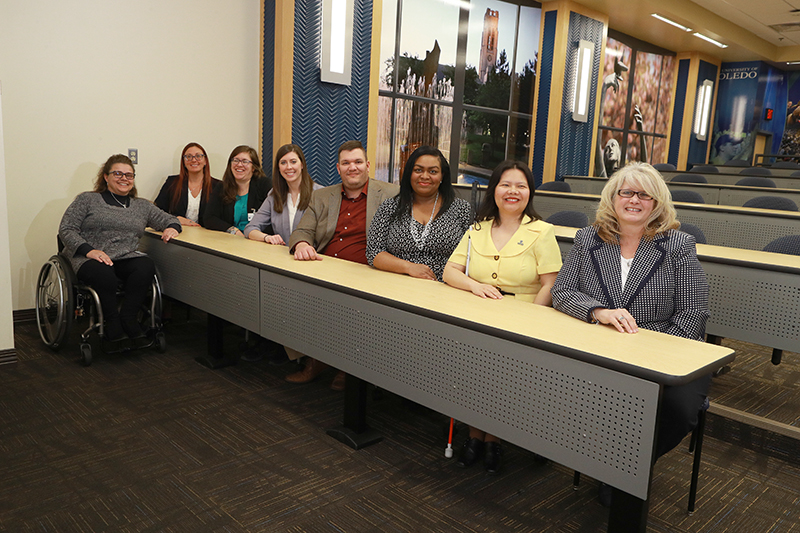Student Disability Services removes barriers to college
All-alumni staff assists students with accommodations, encourages self-advocacy
By Laurie B. Davis

“Lisa was my accessibility specialist,” says Hall (A/S, BA ’03, HHS, BA ’03). “When I came in as a prospective student, they said, ‘Make sure you meet with the Office of Accessibility,’ and I did,” says Hall, who is blind. “That, for me, sealed the decision to come to UT. It was the work of this office and what this office could do for me as an individual with a disability that put UT ahead of every other university, and I think we’re doing the same for other students now,” she says. “I chose to come to Toledo because of Lisa and the positive environment that UT had.”
Hall, now director of the Office of Student Disability Services, oversees a staff of seven, all UT alumni, who serve about 850 UT students who require access through utilizing accommodations and assistive technology to earn their college degrees. Yost is assistant director of the office and serves as an accessibility specialist as well.
As someone who has lived with and experienced blindness, Hall strongly advocates for herself. She also encourages students with disabilities to advocate for themselves. The need for residential and/or academic accommodations for a mobility, sensory, mental or learning disability follows students into post-secondary education. What doesn’t follow is involvement from intervention specialists and parents.
Yost says once students enter college it’s up to them to self-identify as having a disability because this information is confidential throughout the admissions process. That can be a big adjustment from the K-12 education system and the assistance they received, which was more parent-driven. “What I tell students when I meet with them is that they’re truly in the driver’s seat,” says Yost (Ed BA, ’91, A/S MA ’06).
Moving beyond barriers
One alumna who Yost assisted has shown that her disability is simply a part of who she is without defining who she is. Jennifer Porath (BA VPA, ’12) came to UT knowing how to look out for her own best interests and to obtain the accommodations she needed. Yost, who helped accommodate Porath in the classroom, says, “I remember her being very proactive in her needs. She came as a good self-advocate and left as an even better self-advocate.”
Porath, who says she was officially diagnosed with Attention Deficit Disorder, inattentive type, can appear to be paying attention when she really is not. She also was diagnosed with Dysgraphia, a processing disorder. “I have trouble connecting the points between verbal cues into written word. There is a disconnect there. It has been a struggle, but I’ve managed to adapt to what I can do and function under that. Note taking and recordings are usually done on my behalf so I can read or listen to them later,” she says.
Porath’s positive attitude and sense of adventure have helped fuel her academic ambitions, taking her across the ocean to the U.K. “She was the first student I worked with here at UT who traveled abroad,” says Yost, whose own mother was born and raised in England. “It was an exciting adventure for both of us.” As a junior at UT, who had been studying ceramics with Rex Fogt, emeritus professor of art, Porath was off to study at London’s Imperial College. Yost worked with a counterpart at Imperial to arrange for the tools and assistance Porath would need in the classroom. “The big difference when students travel abroad, is that we follow the ADA (Americans with Disabilities Act), but the ADA doesn’t follow students overseas,” says Yost. “Luckily, in a lot of progressive places, like in England, they do accommodations there.”
Porath says Yost corresponded with her contact at Imperial College. “Lisa helped ensure that my rights as a student with a learning disability were observed, and even set up an email contact to allow me to ask my own questions and voice my concerns. She also helped ensure I was on point with my professors and helped me understand another country’s student aid process with regards to learning disabilities.”
Following her study-abroad stint, Porath completed her BA and then returned to the U.K. where she earned two master’s degrees. Currently, she is living in Aberdeen, Scotland, and working toward her PhD in Ethnology and Folklore at the University of Glasgow. (To read about Porath’s adventures backpacking across Europe and her research on Scottish folklore, please follow this link.)
Misconceptions, Misunderstandings and Myths
Yost says she and her colleagues meet one-on-one with each student who has reached out to them. “We look at the diagnosis, we look at the history of accommodations, and then we try and do similar or same and maybe build upon those accommodations while they’re here,” she says. Students also are encouraged to self-disclose to professors and instructors to keep the lines of communication open about their academic needs.
The office’s individualized and interactive approach allows students to decide which accommodations to utilize. “Sometimes students don’t self-identify right away. They don’t want to be that kid anymore,” says Yost. “Everybody will know, everybody will be aware, like they were in K-12 years when everybody knew they had a disability. They don’t realize that they don’t have to use all of the accommodations they might have used in K-12, or that everything in college is very confidential.”
Communication with teachers and students who do not have disabilities can sometimes call for correcting misconceptions. “About 90 percent of our students have non-apparent disabilities. When people think about disability, they think about sensory or mobility, but that’s actually a small piece of who we serve,” explains Hall. Today, the fastest growing category of disabilities stem from depression, anxiety and other mental health disorders as well as learning disabilities, such as ADHD, says Hall.
She says students who use their resources have been told such things as: “You don’t look like somebody with a disability,” or “Here, try this,” or “You just need to try harder.” Hall says professors mean well. “It’s tricky because the professor doesn’t know what the disability is, and it is human nature to make assumptions, but this can cause some misunderstandings.”
How Can We Help?
There are many options for students who need assistance for a disability. UT’s Office of Student Disability Services can provide the following:
- Exam accommodations
- Alternative media, such as course materials and videos that are captioned, electronic text that works with text-to-speech software, braille or large print text
- American Sign Language interpretation or real-time transcription for students who predominately are deaf or hard-of-hearing
- Note-taking assistance and Livescribe Smartpen
- Assistive technology in the virtual lab: learning enhancements, screen enlargement, software that reads, scans and recognizes text, dictation
- Disability management meetings
They also address students’ living arrangements. “We do navigate conversations with students about residence-life living. We have students who maybe need grab bars, we have students who need raised toilets; just about anything you can think of as an accommodation in a hotel, are some of the things that we do here,” says Yost. “Sometimes students require paratransit service, or more of a door-to-door transit service vs. using the loop buses that campus provides. We refer students if they need counseling services or if they need tutoring services,” she adds. Some students also may have emotional support animals in their residences on campus.
One overarching rule dictates the boundaries accessibility specialists must stay within when determining the best ways to help students. “The accommodations that we provide cannot fundamentally alter a course or program of study,” says Yost. “The accommodations are there, to use a cliché, to equal the playing field.”
Hall adds: “We can change the how piece, but we don’t change the what piece. So, they’re still expected to do whatever any other student in that class is expected to do, but they might do it a little differently.”
De-stigmatizing Disability
Hall has experienced a great deal of progress in disability services since coming to UT as an undergraduate student. “When I started as a student, technology was just emerging, and now it’s part of everything that we do.”UT’s Office of Student Disability Services works toward innovation as well. “We’re one of the first in the state to use an online case-management system and the first to have a virtual lab for assistive technology. The first to be able to have a partnership with Disability Studies,” Hall adds.
She also believes the conversation about disabilities is shifting. “I think the field is moving to a social justice model, so that’s something that I’m having the team incorporate into the work we do. For a long time, disability has been left out of the diversity and inclusion conversation. In the last five years or so, there’s been a lot more prevalence in looking at disability as part of that umbrella.”
Hall explains that because diversity is about identity, disability fits within that framework. If disability is seen as an identity, just as gender, race and ethnicity are, then people with disabilities are among all of the other diverse voices who contribute new ideas, opinions, perspectives and solutions.
The perspectives and language that operate in a social justice model come about from framing accommodations around ‘how can we remove barriers’ instead of ‘what are the limitations someone has?’ By reframing the issue and putting focus on the barriers, that makes the issue external to the person with the disability. Now the question becomes, ‘what can be done to change the mode of learning or the environment so it’s more inclusive of people with disabilities?’
Hall says changing the culture of how disability is viewed and placing it among the diversity and inclusion conversation is a shared responsibility and will take many voices to shift perceptions.
Know Your Rights
One of the more positive trends that Hall has seen in her field is that students who were born after the Americans with Disabilities Act was passed by Congress in 1990 feel more confident and less stigmatized by disability. “Because legislation has brought the issue to the forefront for all public entities and provided legal protection for people with disabilities, students can now focus on getting appropriate accommodations,” says Hall.
Confidence and empowerment go hand-in-hand and with them students begin to self-advocate. “Something that our colleague Debbie [Arbogast] says to students is, ‘You live in your shell, you know how you experience your disability, so therefore you’re the best one to explain it.’ And that’s absolutely right.”
Porath has learned to speak up for herself. “The biggest advocate you’ll ever have is yourself,” she says. “Speak up and voice your concerns. You can depend on those who helped you get to where you are, and eventually, you can stand on your own two feet. Stand up and speak up. Know your rights as a student and be proactive in learning about your disability, and educate those around you when you can.”







